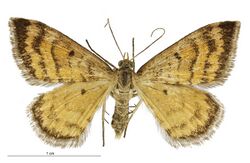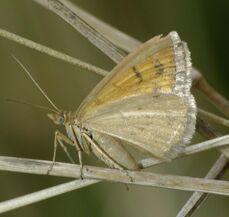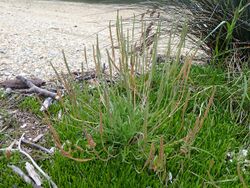Biology:Asaphodes abrogata
| Asaphodes abrogata | |
|---|---|

| |
| Male specimen | |

| |
| Female specimen | |
| Scientific classification | |
| Domain: | Eukaryota |
| Kingdom: | Animalia |
| Phylum: | Arthropoda |
| Class: | Insecta |
| Order: | Lepidoptera |
| Family: | Geometridae |
| Genus: | Asaphodes |
| Species: | A. abrogata
|
| Binomial name | |
| Asaphodes abrogata (Walker, 1862)[1]
| |
| Synonyms[2][3] | |
| |
Asaphodes abrogata is a moth in the family Geometridae.[2] It is endemic to New Zealand and can be found from the central North Island as well as the South Island. This species is inhabits open country at altitudes of between 2000 and 4000 ft. Larvae have been reared on Plantago species including Plantago coronopus. It has been recommended that Plantago raoulii be planted to attracted this species. Adults are on the wing in February and March.
Taxonomy
This species was first described by Francis Walker in 1862 and named Aspilates abrogata, using a specimen collected by P. Earl in Waikouaiti.[4] In 1883 Edward Meyrick placed this species in the Thyone genus and synonymised Fidonia servularia with this species.[5] He discussed this placement and the species in 1884.[6] In 1885 Meyrick replaced the genus name Thyone with Asaphodes.[7] He explained in 1886 that when naming several new genera he had used names that had already been employed and that he had to correct this error.[8] As such he renamed the genus Thyone with the name Asaphodes.[8] In 1898 George Hudson discussed and illustrated this species under the name Asaphodes abrogata.[9] Hudson did the same again in his 1928 publication The butterflies and moths of New Zealand.[10] In 1971 J. S. Dugdale confirmed the placement of this species in the genus Asaphodes.[11] In 1988 Dugdale confirmed this placement in his catalogue of New Zealand Lepidoptera.[2] The holotype of this species is held at the Natural History Museum, London.[2]
Description
Walker described the species as follows:
Male. Pale luteous. Palpi porrect, fringed, rather slender, extending beyond the head. Antennae rather broadly pectinated ; branches remote from each other. Wings with a brown marginal band, which is incomplete in the fore wing. Fore wings slightly acute ; exterior and submarginal lines brownish, undulating, almost parallel, the later apparent here and there on the hind wings. ; costa and exterior border slightly convex, the latter rather oblique. Wings beneath with broader and more distinct lines. Length of the body 5 lines ; of the wings 12 lines.[4]
The distinctiveness of the brown markings of this species is variable and there is sometimes a transverse line near the base of the forewings.[9]
Distribution
This species is endemic to New Zealand and can be found in the central North Island as well as the South Island.[1][12][13]
Behaviour
The adults of this species are on the wing in February and March.[9] Adults are attracted to light.[14]
Habitat and hosts
This species is inhabits open country at altitudes of between 2000 and 4000 ft.[9] Larvae have been reared on Plantago species including Plantago coronopus.[13][15] It has been recommended to plant the endemic species Plantago raoulii to attract this species of moth.[16]
References
| Wikimedia Commons has media related to Asaphodes abrogata. |
- ↑ 1.0 1.1 "Asaphodes abrogata (Walker, 1862)". Landcare Research New Zealand Ltd. http://www.nzor.org.nz/names/cca1a2be-7115-4cb6-bdfe-1d846cb9b4bb.
- ↑ 2.0 2.1 2.2 2.3 , pp. 171, Wikidata Q45083134
- ↑ Natural History Museum; Pitkin, Brian; Jenkins, Paul (2023). Thyone. doi:10.5519/s93616qw. https://www.nhm.ac.uk/our-science/data/butmoth/search/GenusDetails.dsml?NUMBER=29132.0&&. Retrieved 2021-11-17.
- ↑ 4.0 4.1 Walker, Francis (1862). "XXIV: Geometrites (continued)." (in en). List of the Specimens of Lepidopterous Insects in the Collection of the British Museum. pt. 22-24: 1021–1280. https://www.biodiversitylibrary.org/page/39714001.
- ↑ , Wikidata Q106368126
- ↑ , pp. 61, Wikidata Q109615359
- ↑ , Wikidata Q109608428
- ↑ 8.0 8.1 , Wikidata Q109615399
- ↑ 9.0 9.1 9.2 9.3 , pp. 55, Wikidata Q19073637
- ↑ , pp. 107-108, Wikidata Q58593286
- ↑ , Wikidata Q64006453
- ↑ , p. 459, Wikidata Q45922947
- ↑ 13.0 13.1 White, E.G. (2002). New Zealand tussock grassland moths : a taxonomic and ecological handbook based on light-trapping studies in Canterbury. Lincoln, New Zealand: Manaaki Whenua Press. p. 260. ISBN 0478093454.
- ↑ Wood, J. (January 1973). "A List of Lepidoptera Taken in Light Traps at Winchmore Irrigation Research Station" (in en). New Zealand Entomologist 5 (3): 284–290. doi:10.1080/00779962.1973.9723023. ISSN 0077-9962. http://www.tandfonline.com/doi/abs/10.1080/00779962.1973.9723023.
- ↑ , Wikidata Q109608608
- ↑ , Wikidata Q97665452
Wikidata ☰ Q10419101 entry
 |



